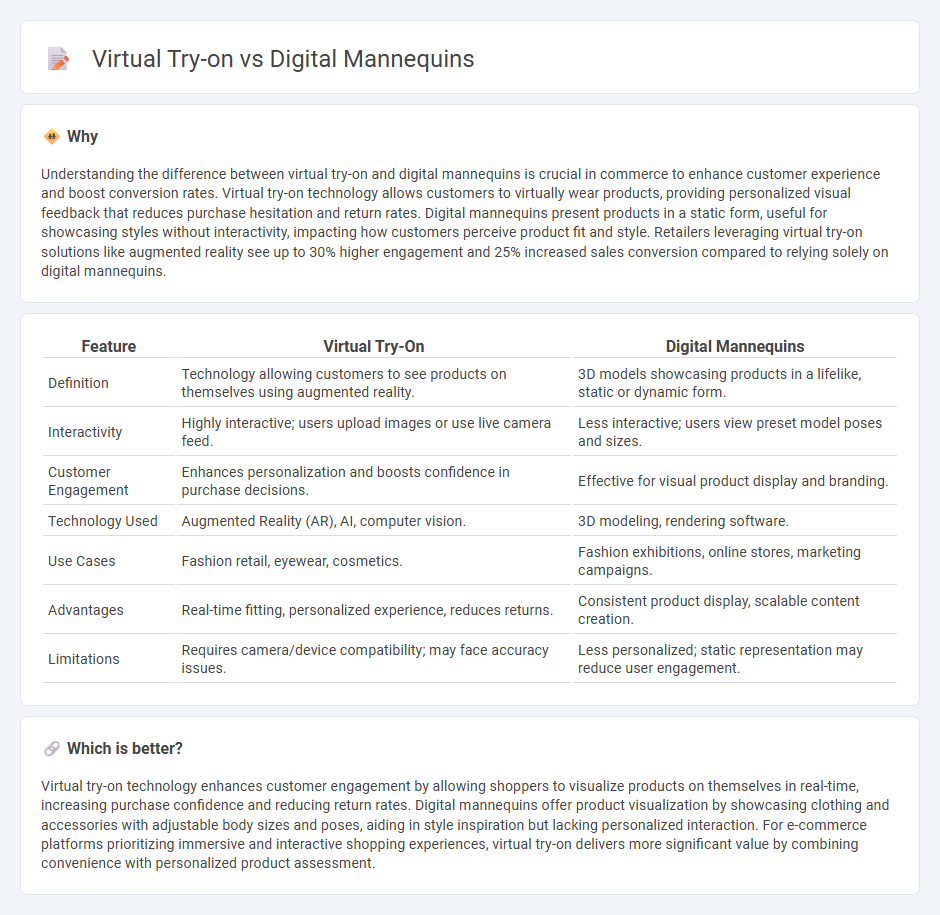
Virtual try-on technology enhances online shopping by allowing customers to visualize products on themselves through augmented reality, improving engagement and reducing return rates. Digital mannequins offer customizable, interactive 3D models that showcase clothing with accurate fit and style details, helping retailers display their inventory more attractively. Explore how these innovative tools are transforming the commerce landscape and boosting consumer confidence.
Why it is important
Understanding the difference between virtual try-on and digital mannequins is crucial in commerce to enhance customer experience and boost conversion rates. Virtual try-on technology allows customers to virtually wear products, providing personalized visual feedback that reduces purchase hesitation and return rates. Digital mannequins present products in a static form, useful for showcasing styles without interactivity, impacting how customers perceive product fit and style. Retailers leveraging virtual try-on solutions like augmented reality see up to 30% higher engagement and 25% increased sales conversion compared to relying solely on digital mannequins.
Comparison Table
| Feature | Virtual Try-On | Digital Mannequins |
|---|---|---|
| Definition | Technology allowing customers to see products on themselves using augmented reality. | 3D models showcasing products in a lifelike, static or dynamic form. |
| Interactivity | Highly interactive; users upload images or use live camera feed. | Less interactive; users view preset model poses and sizes. |
| Customer Engagement | Enhances personalization and boosts confidence in purchase decisions. | Effective for visual product display and branding. |
| Technology Used | Augmented Reality (AR), AI, computer vision. | 3D modeling, rendering software. |
| Use Cases | Fashion retail, eyewear, cosmetics. | Fashion exhibitions, online stores, marketing campaigns. |
| Advantages | Real-time fitting, personalized experience, reduces returns. | Consistent product display, scalable content creation. |
| Limitations | Requires camera/device compatibility; may face accuracy issues. | Less personalized; static representation may reduce user engagement. |
Which is better?
Virtual try-on technology enhances customer engagement by allowing shoppers to visualize products on themselves in real-time, increasing purchase confidence and reducing return rates. Digital mannequins offer product visualization by showcasing clothing and accessories with adjustable body sizes and poses, aiding in style inspiration but lacking personalized interaction. For e-commerce platforms prioritizing immersive and interactive shopping experiences, virtual try-on delivers more significant value by combining convenience with personalized product assessment.
Connection
Virtual try-on technology enhances commerce by allowing customers to digitally visualize products on themselves, increasing confidence in purchasing decisions. Digital mannequins serve as customizable, interactive models that showcase apparel and accessories in a realistic manner, driving higher engagement and conversion rates. Together, these innovations streamline the online shopping experience, reducing return rates and boosting overall sales performance.
Key Terms
Augmented Reality (AR)
Digital mannequins leverage 3D models to display clothing in retail environments, enhancing customer interaction by showcasing fit and style dynamically, while virtual try-on uses augmented reality (AR) to allow customers to visualize garments on themselves in real-time via smartphones or smart mirrors. AR-powered virtual try-on provides a personalized shopping experience by overlaying apparel onto live video feeds, improving engagement and reducing return rates through accurate size and style representation. Explore how these AR technologies transform fashion retail and shopper satisfaction by embracing innovation.
3D Body Scanning
3D body scanning technology serves as the backbone for both digital mannequins and virtual try-on solutions, capturing precise body measurements that enhance garment fit accuracy. Digital mannequins leverage 3D scans to create realistic, adjustable models for designers, while virtual try-on platforms use this data to simulate clothing fit on consumers' avatars in real time. Explore how 3D body scanning transforms apparel customization and shopping experiences.
User Experience (UX)
Digital mannequins offer a tactile, three-dimensional representation of clothing, enhancing user engagement through realistic fabric simulation and adjustable poses. Virtual try-on technologies leverage augmented reality to enable users to visualize garments on their own bodies, improving personalization and convenience in the shopping journey. Discover the impact of these innovations on optimizing user experience in fashion retail.
Source and External Links
Digital mannequin - lifelike product representations - Grassfish - Digital mannequins combine high-resolution screens and motion sensors to create interactive, customizable displays that enhance customer experience, increase sales, reduce display costs, and provide insightful analytics for retailers.
Redefining Beauty Standards with Digital Mannequins - Hypervsn - Digital mannequins allow brands to showcase diverse body types and sizes, helping to challenge outdated beauty ideals and foster inclusivity, improving shopper connection and mental well-being.
The Future of the Store Mannequin: Diverse, Digital and Data-Driven - Digital mannequins utilize 3D holograms and consumer-interactive features like QR code-based customization, integrating real-time data to enhance personalized shopping experiences and link online and offline retail analytics.
 dowidth.com
dowidth.com